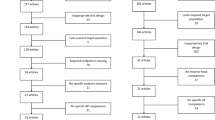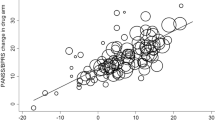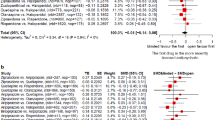Abstract
In recent years, so-called “effectiveness studies” have gained increasing importance in the context of evidence-based medicine. These studies supposedly follow less restrictive methodological standards than phase III studies in terms of patient selection, co-medication and other design issues, and their results should therefore be better generalisable than those of phase III studies. Effectiveness studies, like other types of phase IV studies, can therefore contribute to the knowledge about antipsychotics or other psychopharmaceuticals and supply relevant information in addition to that gained from phase III trials. However, the less restrictive design and inherent methodological problems of phase IV studies mean that their results cannot falsify the results of phase III studies. The greater complexity of phase IV studies, for example the greater variance caused by the different kinds of confounders, means that their results have to be interpreted with great care and especially with a high degree of awareness of problematic design issues, such as insensitive primary outcome criteria, biased randomisation, unblinded treatment conditions, inclusion of chronic refractory patients, etc. Some recently published effectiveness studies on antipsychotic treatment of schizophrenia will be discussed under these methodological aspects. The main conclusions of these trials will be questioned on the basis of their severe methodological pitfalls.

Similar content being viewed by others
Reference
Adam D, Kasper S, Möller HJ, Singer EA (2005) Placebo-controlled trials in major depression are necessary and ethically justifiable: how to improve the communication between researchers and ethical committees. Eur Arch Psychiatry Clin Neurosci 255:258–260
Awad AG, Voruganti LN (2004) New antipsychotics, compliance, quality of life, and subjective tolerability—are patients better off? Can J Psychiatry 49:297–302
Baldwin D, Broich K, Fritze J, Kasper S, Westenberg H, Möller HJ (2003) Placebo-controlled studies in depression: necessary, ethical and feasible. Eur Arch Psychiatry Clin Neurosci 253:22–28
Barak Y, Shamir E, Mirecki I, Weizman R, Aizenberg D (2004) Switching elderly chronic psychotic patients to olanzapine. Int J Neuropsychopharmacol 7:165–169
Bender S, Dittmann-Balcar A, Schall U, Wolstein J, Klimke A, Riedel M, Vorbach EU, Kuhn KU, Lambert M, Dittmann RW et al (2006) Influence of atypical neuroleptics on executive functioning in patients with schizophrenia: a randomized, double-blind comparison of olanzapine vs. clozapine. Int J Neuropsychopharmacol 9:135–145
Buckley PF (2007) Receptor-binding profiles of antipsychotics: clinical strategies when switching between agents. J Clin Psychiatry 68(suppl 6):5–9
Buckley PF, Harvey PD, Bowie CR, Loebel A (2007) The relationship between symptomatic remission and neuropsychological improvement in schizophrenia patients switched to treatment with ziprasidone. Schizophr Res 94:99–106
Caley CF, Weber SS (1995) Sulpride: an antipsychotic with selective dopaminergic antagonist properties. Ann Pharmacother 29:152–160
Cramer JA, Rosenheck R, Xu W, Thomas J, Henderson W, Charney DS (2000) Quality of life in schizophrenia: a comparison of instruments. Department of Veterans Affairs Cooperative Study Group on clozapine in refractory schizophrenia. Schizophr Bull 26:659–666
Dossenbach MR, Folnegovic-Smalc V, Hotujac L, Uglesic B, Tollefson GD, Grundy SL, Friedel P, Jakovljevic MM (2004) Double-blind, randomized comparison of olanzapine versus fluphenazine in the long-term treatment of schizophrenia. Prog Neuropsychopharmacol Biol Psychiatry 28:311–318
Essock SM, Covell NH, Davis SM, Stroup TS, Rosenheck RA, Lieberman JA (2006) Effectiveness of switching antipsychotic medications. Am J Psychiatry 163:2090–2095
Falkai P, Wobrock T, Lieberman J, Glenthoj B, Gattaz WF, Moller HJ (2005) World Federation of Societies of Biological Psychiatry (WFSBP) guidelines for biological treatment of schizophrenia, Part 1: acute treatment of schizophrenia. World J Biol Psychiatry 6:132–191
Falkai P, Wobrock T, Lieberman J, Glenthoj B, Gattaz WF, Moller HJ (2006) World Federation of Societies of Biological Psychiatry (WFSBP) guidelines for biological treatment of schizophrenia, part 2: long-term treatment of schizophrenia. World J Biol Psychiatry 7:5–40
Franz M, Lis S, Pluddemann K, Gallhofer B (1997) Conventional versus atypical neuroleptics: subjective quality of life in schizophrenic patients. Br J Psychiatry 170:422–425
Glick ID (2006) Understanding the results of CATIE in the context of the field. CNS Spectr 11:40–47
Hegerl U, Juckel G, Muller-Schubert A, Pietzcker A, Gaebel W (1995) Schizophrenics with small P300: a subgroup with a neurodevelopmental disturbance and a high risk for tardive dyskinesia? Acta Psychiatr Scand 91:120–125
Heinrichs DW, Hanlon TE, Carpenter WT Jr (1984) The Quality of life scale: an instrument for rating the schizophrenic deficit syndrome. Schizophr Bull 10:388–398
Heres S, Davis J, Maino K, Jetzinger E, Kissling W, Leucht S (2006) Why olanzapine beats risperidone, risperidone beats quetiapine, and quetiapine beats olanzapine: an exploratory analysis of head-to-head comparison studies of second-generation antipsychotics. Am J Psychiatry 163:185–194
Hofer A, Hummer M, Huber R, Kurz M, Walch T, Fleischhacker WW (2000) Selection bias in clinical trials with antipsychotics. J Clin Psychopharmacol 20:699–702
Hogarty GE, Goldberg SC (1973) Drug and sociotherapy in the aftercare of schizophrenic patients. One-year relapse rates. Arch Gen Psychiatry 28:54–64
Hugenholtz GW, Heerdink ER, Stolker JJ, Meijer WE, Egberts AC, Nolen WA (2006) Haloperidol dose when used as active comparator in randomized controlled trials with atypical antipsychotics in schizophrenia: comparison with officially recommended doses. J Clin Psychiatry 67:897–903
Jones PB, Barnes TR, Davies L, Dunn G, Lloyd H, Hayhurst KP, Murray RM, Markwick A, Lewis SW (2006) Randomized controlled trial of the effect on quality of life of second- vs first-generation antipsychotic drugs in schizophrenia: cost utility of the Latest Antipsychotic Drugs in Schizophrenia Study (CUtLASS 1). Arch Gen Psychiatry 63:1079–1087
Kane JM (2006) Commentary on the clinical antipsychotic trials of intervention effectiveness (CATIE). J Clin Psychiatry 67:831–832
Karow A, Naber D (2002) Subjective well-being and quality of life under atypical antipsychotic treatment. Psychopharmacology (Berl) 162:3–10
Kasper S, Winkler D (2006) Addressing the limitations of the CATIE study. World J Biol Psychiatry 7:126–127
Kupfer DJ, Sartorius N (2003) The usefulness and use of second-generation antipsychotic medication—an update. Curr Opin Psychiatry 16(suppl 1):S1–S44
Lambert M, Naber D (2004) Current issues in schizophrenia: overview of patient acceptability, functioning capacity and quality of life. CNS Drugs 18(suppl 2):5–17
Lavin MR, Rifkin A (1991) Prophylactic antiparkinson drug use: II. Withdrawal after long-term maintenance therapy. J Clin Pharmacol 31:769–777
Lehman AF, Kreyenbuhl J, Buchanan RW, Dickerson FB, Dixon LB, Goldberg R, Green-Paden LD, Tenhula WN, Boerescu D, Tek C et al (2004) The Schizophrenia Patient Outcomes Research Team (PORT): updated treatment recommendations 2003. Schizophr Bull 30:193–217
Lehman AF, Lieberman JA, Dixon LB, McGlashan TH, Miller AL, Perkins DO, Kreyenbuhl J (2004) Practice guideline for the treatment of patients with schizophrenia, 2nd edn. Am J Psychiatry 161:1–56
Leucht S, Pitschel-Walz G, Abraham D, Kissling W (1999) Efficacy and extrapyramidal side-effects of the new antipsychotics olanzapine, quetiapine, risperidone, and sertindole compared to conventional antipsychotics and placebo. A meta-analysis of randomized controlled trials. Schizophr Res 35:51–68
Lewis SW, Barnes TR, Davies L, Murray RM, Dunn G, Hayhurst KP, Markwick A, Lloyd H, Jones PB (2006) Randomized controlled trial of effect of prescription of clozapine versus other second-generation antipsychotic drugs in resistant schizophrenia. Schizophr Bull 32:715–723
Lieberman JA (2006) Comparative effectiveness of antipsychotic drugs. A commentary on: Cost Utility Of The Latest Antipsychotic Drugs In Schizophrenia Study (CUtLASS 1) and Clinical Antipsychotic Trials Of Intervention Effectiveness (CATIE). Arch Gen Psychiatry 63:1069–1072
Lieberman JA, Alvir J, Geisler S, Ramos-Lorenzi J, Woerner M, Novacenko H, Cooper T, Kane JM (1994) Methylphenidate response, psychopathology and tardive dyskinesia as predictors of relapse in schizophrenia. Neuropsychopharmacology 11:107–118
Lieberman JA, Stroup TS, McEvoy JP, Swartz MS, Rosenheck RA, Perkins DO, Keefe RS, Davis SM, Davis CE, Lebowitz BD et al (2005) Effectiveness of antipsychotic drugs in patients with chronic schizophrenia. N Engl J Med 353:1209–1223
Lieberman JA, Tollefson G, Tohen M, Green AI, Gur RE, Kahn R, McEvoy J, Perkins D, Sharma T, Zipursky R et al (2003) Comparative efficacy and safety of atypical and conventional antipsychotic drugs in first-episode psychosis: a randomized, double-blind trial of olanzapine versus haloperidol. Am J Psychiatry 160:1396–1404
Maier W, Moller HJ (2007) Meta-analyses: a tool for maximizing therapy study evidence?. Nervenarzt 78:1028–1036
Manos N, Lavrentiadis G, Gkiouzepas J (1986) Evaluation of the need for prophylactic antiparkinsonian medication in psychotic patients treated with neuroleptics. J Clin Psychiatry 47:114–116
McCue RE, Waheed R, Urcuyo L, Orendain G, Joseph MD, Charles R, Hasan SM (2006) Comparative effectiveness of second-generation antipsychotics and haloperidol in acute schizophrenia. Br J Psychiatry 189: 433–440
McEvoy JP, Lieberman JA, Stroup TS, Davis SM, Meltzer HY, Rosenheck RA, Swartz MS, Perkins DO, Keefe RS, Davis CE et al (2006) Effectiveness of clozapine versus olanzapine, quetiapine, and risperidone in patients with chronic schizophrenia who did not respond to prior atypical antipsychotic treatment. Am J Psychiatry 163:600–610
Meltzer HY, Bobo WV (2006) Interpreting the efficacy findings in the CATIE study: what clinicians should know. CNS Spectr 11:14–24
Miller DD, McEvoy JP, Davis SM, Caroff SN, Saltz BL, Chakos MH, Swartz MS, Keefe RS, Rosenheck RA, Stroup TS et al (2005) Clinical correlates of tardive dyskinesia in schizophrenia: baseline data from the CATIE schizophrenia trial. Schizophr Res 80:33–43
Möller HJ (2000) Rating depressed patients: observer- vs self-assessment. Eur Psychiatry 15:160–172
Möller HJ (2003) Amisulpride: limbic specificity and the mechanism of antipsychotic atypicality. Prog Neuropsychopharmacol Biol Psychiatry 27:1101–1111
Möller HJ (2003) Plazebo-kontrollierte Studien zum Wirkungsnachweis von Antidepressiva sind notwendig! Psychopharmakotherapie 10:85–86
Möller HJ (2004) Sind placebokontrollierte Studien zum Wirksamkeitsbeweis von Antidepressiva notwendig? Nervenarzt 5:421–424
Möller HJ (2005) Are the new antipsychotics no better than the classical neuroleptics? The problematic answer from the CATIE study. Eur Arch Psychiatry Clin Neurosci 255:371–372
Möller HJ (2007) “Effectiveness”-Studien: methodische Mängel und negative Konsequenzen für die Versorgung. Psychopharmakotherapie 14:45–46
Möller HJ (2008) Standardised rating scales in psychiatry: methodological basis, possibilities, limitations and descriptions of important rating scales. World J Biol Psychiatry (in press)
Moller HJ, Maier W (2007) Problems of evidence-based medicine in psychopharmacotherapy: problems of evidence grading and of the evidence basis for complex clinical decision making. Nervenarzt 78:1014–1027
Mudge MAC, Davey PJ, Coleman KA, Montgomery W, Croker VS, Mullen K, Castle DJ (2005) A comparison of olanzapine versus risperidone for the treatment of schizophrenia: a meta-analysis of randomised clinical trials. Int J Psychiatry Clin Prac 9:3–15
Mulert C, Juckel G, Giegling I, Pogarell O, Leicht G, Karch S, Mavrogiorgou P, Moller HJ, Hegerl U, Rujescu D (2006) A Ser9Gly polymorphism in the dopamine D3 receptor gene (DRD3) and event-related P300 potentials. Neuropsychopharmacology 31:1335–1344
Murray RM, O’Callaghan E, Castle DJ, Lewis SW (1992) A neurodevelopmental approach to the classification of schizophrenia. Schizophr Bull 18:319–332
Murray RM, Van Os J (1998) Predictors of outcome in schizophrenia. J Clin Psychopharmacol 18:2S–4S
Naber D (2005) Subjective effects of antipsychotic treatment. Acta Psychiatr Scand 111:81–83
Oosthuizen P, Emsley R, Jadri TH, Keyter N (2004) A randomized, controlled comparison of the efficacy and tolerability of low and high doses of haloperidol in the treatment of first-episode psychosis. Int J Neuropsychopharmacol 7:125–131
Oosthuizen PP, Emsley RA, Maritz JS, Turner JA, Keyter N (2003) Incidence of tardive dyskinesia in first-episode psychosis patients treated with low-dose haloperidol. J Clin Psychiatry 64:1075–1080
Paykel ES, Norton KRW (1986) Self-report and clinical interview in the assessment of depression. In: Sartorius N, Ban TA (eds) Assessment of depression. Springer, New York, pp 356–366
Phillips GA, Van Brunt DL, Roychowdhury SM, Xu W, Naber D (2006) The relationship between quality of life and clinical efficacy from a randomized trial comparing olanzapine and ziprasidone. J Clin Psychiatry 67:1397–1403
Pukrop R, Möller HJ, Steinmeyer EM (2000) Quality of life in psychiatry: a systematic contribution to construct validation and the development of the integrative assessment tool “modular system for quality of life”. Eur Arch Psychiatry Clin Neurosci 250:120–132
Pukrop R, Schlaak V, Möller-Leimkühler AM, Albus M, Czernik A, Klosterkötter J, Möller HJ (2003) Reliability and validity of quality of life assessed by the Short-Form 36 and the modular system of quality of life in patients with schizophrenia and patients with depression. Psych Res 119:63–79
Pyne JM, Sullivan G, Kaplan R, Williams DK (2003) Comparing the sensitivity of generic effectiveness measures with symptom improvement in persons with schizophrenia. Med Care 41:208–217
Ragins M (2005) Should the CATIE study be a wake-up call? Psychiatr Serv 56:1489
Rosenheck R, Perlick D, Bingham S, Liu-Mares W, Collins J, Warren S, Leslie D, Allan E, Campbell EC, Caroff S et al (2003) Effectiveness and cost of olanzapine and haloperidol in the treatment of schizophrenia: a randomized controlled trial. JAMA 290:2693–2702
Rosenheck RA (2006) Outcomes, costs, and policy caution. A commentary on: the Cost Utility of the Latest Antipsychotic Drugs in Schizophrenia Study (CUtLASS 1). Arch Gen Psychiatry 63:1074–1076
Schatzberg AF, Nemeroff CB (2000) The American psychiatric publishing textbook of psychopharmacology, 3rd edn. American Psychiatric Publishing, Washington DC
Soares BG, Fenton M, Chue P (2000) Sulpiride for schizophrenia. Cochrane Database Syst Rev: CD001162
Soares KV, McGrath JJ (2000) Anticholinergic medication for neuroleptic-induced tardive dyskinesia. Cochrane Database Syst Rev: CD000204
Sramek JJ, Simpson GM, Morrison RL, Heiser JF (1986) Anticholinergic agents for prophylaxis of neuroleptic-induced dystonic reactions: a prospective study. J Clin Psychiatry 47:305–309
Stern TA, Anderson WH (1979) Benztropine prophylaxis of dystonic reactions. Psychopharmacology (Berl) 61:261–262
Stroup TS, Lieberman JA, McEvoy JP, Swartz MS, Davis SM, Rosenheck RA, Perkins DO, Keefe RS, Davis CE, Severe J et al (2006) Effectiveness of olanzapine, quetiapine, risperidone, and ziprasidone in patients with chronic schizophrenia following discontinuation of a previous atypical antipsychotic. Am J Psychiatry 163:611–622
Stroup TS, McEvoy JP, Swartz MS, Byerly MJ, Glick ID, Canive JM, McGee MF, Simpson GM, Stevens MC, Lieberman JA (2003) The National Institute of Mental Health Clinical Antipsychotic Trials of Intervention Effectiveness (CATIE) project: schizophrenia trial design and protocol development. Schizophr Bull 29:15–31
Strous RD, Kupchik M, Roitman S, Schwartz S, Gonen N, Mester R, Weizman A, Spivak B (2006) Comparison between risperidone, olanzapine, and clozapine in the management of chronic schizophrenia: a naturalistic prospective 12-week observational study. Hum Psychopharmacol 21:235–243
Tandon R, Möller HJ, Belmaker RH, Gattaz WF, Lopez-Ibor JJ, Okasha A, Burrows G, Stein DJ, Olie JP, Nutt D, et al. (2008) World Psychiatric Association Pharmacopsychiatry section statement on comparative effectiveness of antipsychotics in the treatment of schizophrenia. Schizophr Res (in press)
Tiihonen J, Walhbeck K, Lonnqvist J, Klaukka T, Ioannidis JP, Volavka J, Haukka J (2006) Effectiveness of antipsychotic treatments in a nationwide cohort of patients in community care after first hospitalisation due to schizophrenia and schizoaffective disorder: observational follow-up study. BMJ 333:224
Tunis SL, Johnstone BM, Gibson PJ, Loosbrock DL, Dulisse BK (1999) Changes in perceived health and functioning as a cost-effectiveness measure for olanzapine versus haloperidol treatment of schizophrenia. J Clin Psychiatry 60 (suppl 19):38–45
Tunis SR, Stryer DB, Clancy CM (2003) Practical clinical trials: increasing the value of clinical research for decision making in clinical and health policy. JAMA 290:1624–1632
Ware JE, Jr., Sherbourne CD (1992) The MOS 36-item short-form health survey (SF-36). I. Conceptual framework and item selection. Med Care 30:473–483
Ware JE, Snow KK, Kosinski M, Gandek B (1993) SF-36 Health Survey Manual and Interpretation Guide. The Health Institute, New England Medical Center, Boston
Weiden PJ (2006) Switching antipsychotics: an updated review with a focus on quetiapine. J Psychopharmacol 20:104–118
Weiden PJ (2007) Discontinuing and switching antipsychotic medications: understanding the CATIE schizophrenia trial. J Clin Psychiatry 68(suppl 1):12–9
Weiden PJ, Simpson GM, Potkin SG, O’Sullivan RL (2003) Effectiveness of switching to ziprasidone for stable but symptomatic outpatients with schizophrenia. J Clin Psychiatry 64:580–588
Author information
Authors and Affiliations
Corresponding author
Rights and permissions
About this article
Cite this article
Möller, HJ. Do effectiveness (“real world”) studies on antipsychotics tell us the real truth?. Eur Arch Psychiatry Clin Neurosc 258, 257–270 (2008). https://doi.org/10.1007/s00406-008-0812-0
Received:
Accepted:
Published:
Issue Date:
DOI: https://doi.org/10.1007/s00406-008-0812-0




